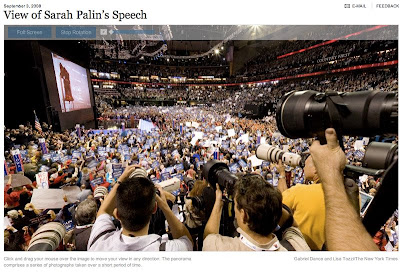Thanks to Nhat V Meyer of the San Jose Mercury News for posting (via the NewspaperVideo Yahoo group) a link to VRWave.com. It looks like the site is under construction, but it's already worthy due to its excellent list of lenses (Canon, Nikon, etc.) and their specifications for panoramic use.
Not only do we use fisheyes for panoramas, we can also use conventional lenses (both prime and zoom). And, we don't have to shoot full 360x180 panoramas - partial cylindrical panoramas can work quite well for story telling especially if you need a really wide view. If you remember the Widelux or Horizon panoramic film cameras, these panoramas will remind you of that"bananarama" effect. Here's an example I shot earlier this year where I needed to have both the building we were reporting on and the skyline. Another advantage of cylindrical panos is they're easier to publish in print - you don't have the extreme distortion at the top and bottom of the images as in equirectangular projections.
The database includes Field of View parameters for these lenses, and (this is the best part) it tells you how to set up a multi-row panorama. The key info is: pitch in degrees for each row, number of rows, and number of images per row. This is key information if you're going to stitch a multi-row, high-resolution panorama for posting to gigapan.org (see an earlier post for details). PTGui handles these multi-row panoramas quite nicely.
Tuesday, September 9, 2008
Monday, September 8, 2008
Damn Near Perfect

Back from Beijing, Gabriel Dance of nyt.com puts the viewer there during Sarah Palin's speech at the Republican National Convention. I was struck by this pano in that I can't find a single stitching error anywhere, which is impressive given the situation and subject matter.
I asked Gabriel about the shoot and his gear. Here's his response, which sums up the difficulties of making panos in these situations:
Camera: 5D, 15mm fisheye lens
Rig: ballhead tripod, nodal ninja 5
Stitching: PTGUI Pro
"The most difficult thing about these shots is getting them (which
sounds obvious), but really in these types of situations, as you well
know, all the photogs are trying to get their shots and it's a
balancing act between getting the pano, and not getting shanked by an
angry photog's monopod after blocking their shot. And the space is at
a premium as you can tell from the pano. For this one I was on the
stage left cut-stand and I made sure to get their a good hour before
the shot. Shake hands with the other photographers and let them know
what I'm doing. Let them know that I'll keep my tripod tight and in
my spot. Then, when the time is right, hit the shots as quickly as I
can, making sure not to push/move/lean on the tripod.
And hope for the best...
Then it's some Photoshop, just a little bit of layer blending is
sometimes necessary in case anybody is obviously cut in half, and then
we're done. With these speed is essential. I had this up a lil over
an hour after it was shot."
The embedded audio (recorded by Lisa Tozzi) is an excellent addition.
Labels:
gabriel dance,
GOP convention,
news panoramas,
nyt.com,
PTGui
Subscribe to:
Comments (Atom)